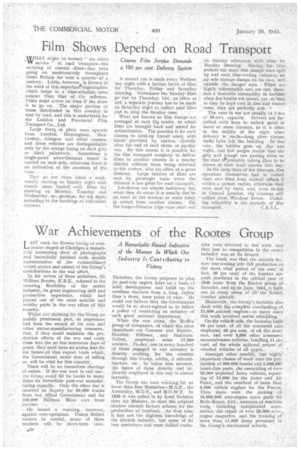War. Achievements of the Rootes Group
Page 22

If you've noticed an error in this article please click here to report it so we can fix it.
A Remarkable Record Indicative of the Manner In Which Our Industry Is Contributing to Victory. T AST week the Rootes Gronp of coml..i ponies staged at Claridges a remarkably interesting show of photographs and beautifully finished scale models representative of .the extraordinary varied nature and extent of the Group's contributions to the war effort. In his review of these activities, Sir William Rootes, K.B.E. referred to the amazing flexibility Of the motor industry, its great engineering skill and production experience, which had played one of the most notable and worthy parts in the war effort of this country.
Whilst not claiming for the Group an unduly prominent part, so impressive had been the record of his own and other motor-manufacturing concerns, that, if they could maintain the production efforts of the war and carry them intei the no less strenuous days of peace, they need have no undue fear for the future ,of that export trade which, the Government never tires of telling us, will he vital for this country.
There will be no immediate shortage 'of orders. If the war were to 'end now, the Group could fill its books to many times its immediate post-war manufacturing capacity. Only the other day it received an inquiry for 60,000 trucks from one Allied Government and for 100,000 'Hillman Minx cars from another.
. Ire issued a warning, however, against oVer-optimism. Unless British makers be careful, many of these markets will be short-term ones.
Therefore, the Group proposes to plan its post-war export drive on a basis cf 'solid deVelopment and build up the overSeas markets from a long, rasher than a short, term point of view. He could not believe that the Government would be so short-sighted as to follow a policy of restricting an industry of such great national importance.
When the war came, the Rodtes group of companies, of which the mbst important are Commer and Karrier, Humber, Hillman, and SunbeamTalbot, employed some 17,000 workers. .To-day, one in every hundred of those engaged in war industry is directly working for the country through this Group, whilst, if sub-contractors, etc., be taken into account, the figure of those directly and indirectly employed in this way is almost fantastic.
The Group has been working for no fewer than four Ministries—M.A.P., the Admiralty, M.O.S., and M.O.W.T. In 1936 it was called in by Lord Swinton then Air Minister, to start the original shadow aircraft factory scheme for the production of bombers. -At that time it had not the slightest knowledge of the aircraft industry, but some of its best exedutives and most skilled crafts
men were diverted to this work, and that just as competition in the motor industry was at its fiercest.
The result was that the aircraft factory was coming into full production at the most vital period of the war; in fact, 30 per cent: of the bomber aircraft produced in the critical year of IWO came from the Rootes group of factories, and up to June, 1944„ it built one in every seven of all the British bomber 'aircraft.
Meanwhile, the Group's factories also dealt with the complete overhauling of 21,000 aircraft engines—in many cases this work involved entire rebuilding.
On the vchiclh side, the factories built 60 per 'cent, of all the armoured cars employed, 35 per cent, of all the scout cars, and over 3,600 other armoured reconnaissance vehicles, totalling 11 per cent, of the whole national output of wheeled vehicles of all types. ,
Amongst other smaller, but highly important classes of work were the production of 300,000 bombs and 5,000,000 bomb-fuse parts, the assembling of over 20,000 imported Army vehicles, repairing of 12,000 for the Army and Air Force, and the overhaul of more than 9,000 vehicle engines for the Forces. Then there were the making of 10,000,000 aero-engine spare parts for Rolls-Royce, Ltd., numbers of machine tools, including complicated automatics, the repair ot over 28,000 acro-, engine magnetos, and the training of more than 11,000 Army personae} in the Group's mechanical schools.




















































